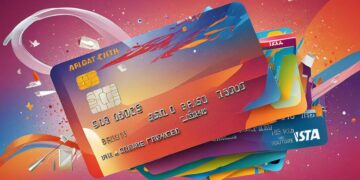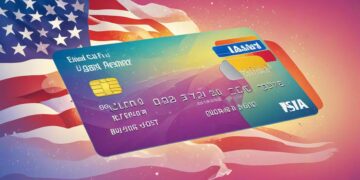Common mistakes when using credit cards in the United States

The Importance of Understanding Credit Card Pitfalls
Credit cards, when used judiciously, can be a gateway to numerous financial advantages. They not only provide convenience but also offer rewards ranging from cash back to travel points, making them appealing to consumers. However, many individuals in the United States find themselves ensnared in pitfalls that can lead to long-term financial distress. By understanding these challenges, credit card users can leverage their cards to their advantage rather than allowing them to hinder their financial growth.
Here are some common mistakes to watch out for:
- Accumulating Debt: One of the most significant drawbacks of credit cards is the temptation to overspend. It is easy to lose track of expenses when you can make purchases without immediate payment. High-interest rates on unpaid balances can lead to spiraling debt, making it challenging to achieve financial stability. For instance, the average credit card interest rate can range from 15% to 25%, meaning that a $1,000 balance could cost you anywhere from $150 to $250 in interest annually, if left unpaid.
- Missing Payments: Another prevalent mistake is the failure to make timely payments. Late payments can incur significant fees, often around $40, and can damage your credit score, making it harder to obtain loans in the future. Credit scores are pivotal in determining interest rates and lending decisions; hence, a single missed payment can set you back considerably. For example, a score drop from 700 to 650 can lead to an increase of 1% to 2% in your mortgage interest rate.
- Ignoring Rewards: Many credit card holders overlook the potential benefits tied to their cards, such as rewards programs and cash-back offers. Not taking advantage of these features means leaving money on the table. For instance, some cards offer up to 5% cash back on specific categories like groceries or gas, which can accumulate to significant savings over time. By simply adjusting your spending habits to align with these rewards, you can maximize the benefits your card offers.
According to a recent survey, nearly 30% of credit card holders report challenges with repayment, further underscoring the need for education around effective credit use. Understanding the common pitfalls and how to avoid them can empower consumers to wield credit cards as beneficial financial tools rather than sources of stress.
In the following sections, we will explore these mistakes in greater detail and provide actionable tips on how to navigate the credit landscape responsibly. From budgeting strategies to optimizing rewards programs, being informed can pave the way for improved financial health and enhanced decision-making. This knowledge is crucial not only for novices but also for seasoned users seeking to sharpen their financial acumen.
SEE ALSO: Click here to read another article
Navigating the Complexities of Credit Card Usage
Understanding credit cards in the United States involves more than just knowing how to swipe and pay. It requires a keen awareness of the potential pitfalls that can turn a financial tool into a daunting burden. One of the most rampant issues credit card users face is **accumulating debt**. As previously mentioned, the psychological allure of a credit card often encourages overspending. With available credit at your fingertips, it’s all too easy to exceed your budget. In fact, a 2019 study found that the average American credit cardholder carries about $6,194 in debt. This staggering figure highlights the necessity for oversight and discipline when it comes to monitoring credit usage.
To help navigate these turbulent waters, here are some tips to keep your spending in check:
- Set a Monthly Budget: Determine how much you can afford to spend on your credit card each month. Keep track of your expenses to ensure you don’t exceed this budget.
- Use Alerts: Take advantage of mobile banking alerts that notify you when you’re nearing your credit limit or when bills are due. These can serve as handy reminders to keep your spending in line.
- Only use credit for necessary purchases: If the purchase isn’t essential or can be delayed, consider saving for it instead of relying on your credit card.
Next on the list of common mistakes is the tendency to **miss payments**. Many consumers underestimate the impact of late payments on their financial health. A *late payment* can not only incur fees but may also increase your interest rates and significantly damage your credit score. According to FICO, the leading company that generates credit scores, a late payment can cause your score to drop by as much as 180 points, depending on your baseline credit score. This drop can translate to higher borrowing costs for future loans, such as a mortgage or an auto loan.
To avoid falling into this trap, consider the following practices:
- Automate Payments: Schedule automatic monthly payments for at least the minimum amount due to prevent missed deadlines.
- Create a Payment Calendar: Mark important dates on your calendar, such as billing cycles and payment due dates, to help you stay on track.
- Review Your Statements: Regularly check your statements to ensure accuracy. This can also help you identify areas where you may be overspending.
Additionally, another misunderstood area is the failure to **utilize rewards** associated with credit cards effectively. Many users treat credit cards as mere transactional tools, neglecting the lucrative rewards programs that can significantly benefit them. Whether it’s travel points, cash back, or discounts, these rewards can stack up quickly if you are strategic about your spending. For example, some cards offer up to 3% cash back on dining or travel expenses. By aligning your credit card use with these reward categories, you can maximize your earnings and accumulate perks you might otherwise miss.
Recognizing these prevalent mistakes and understanding how to avoid them can empower consumers to take control of their finances. In the evolving credit landscape, being well-informed allows you to use credit cards as effective financial instruments instead of letting them become sources of stress.
SEE ALSO: Click here to read another article
Overlooking Fees and Terms: The Hidden Costs of Credit Card Use
While many consumers understand the face value of their credit card bills, they often overlook the multitude of hidden fees and complex terms that can significantly affect their financial health. One common mistake is ignoring annual fees. Many credit cards come with a yearly fee that can range from a modest amount to several hundred dollars for premium cards. For instance, a study from CreditCards.com shows that over 30% of Americans do not realize their credit card has an annual fee. Failing to account for this fee can lead to an unanticipated drain on your finances.
Moreover, users may not be fully aware of their credit card’s interest rate or APR (Annual Percentage Rate). When carrying a balance, the interest can accumulate rapidly, increasing the total amount owed exponentially. A credit card’s interest rate can vary based on a multitude of factors, including the user’s creditworthiness at the time of application. As of October 2023, the average credit card interest rate hovers around 20.4%, putting significant pressure on those who don’t pay their balance in full each month.
To stave off these hidden costs, consumers should:
- Review All Fees: Carefully read the terms and conditions of your credit card, paying special attention to any fees associated, including annual fees, late payment fees, and foreign transaction fees.
- Negotiate Rates: If you have a good payment history, consider calling your credit card issuer to negotiate a lower interest rate.
- Factor in Costs: When selecting a credit card, consider not only the rewards but also any fees that may apply throughout the year.
Ignoring Credit Utilization Ratio: A Key Indicator of Financial Health
Another common oversight among credit card users is failing to monitor their credit utilization ratio. This metric reflects the amount of credit used compared to the total credit limit available and plays a pivotal role in determining credit scores. Ideally, keeping your utilization ratio below 30% is crucial. A high ratio can signal financial distress to lenders and may lead to a decline in your credit score. Unfortunately, many users do not realize this until they apply for a major credit product, where a lower score can result in denied applications or less favorable terms.
To maintain a healthy credit utilization ratio, consider these strategies:
- Request Higher Credit Limits: If you demonstrate a consistent payment history, ask your issuer for a credit limit increase, which can lower your utilization ratio even if your spending remains the same.
- Manage Balances Carefully: Aim to pay down existing credit card balances before making new purchases to keep your utilization rates attractive.
- Spread Transactions: If possible, use multiple cards for purchases to help keep individual utilization ratios lower across accounts.
Neglecting to Monitor Credit Reports
Lastly, many consumers overlook the importance of actively monitoring their credit reports. Regularly checking credit reports is essential in maintaining good financial health and catching errors or fraudulent activity early. Studies from recent years indicate that as many as 1 in 5 Americans may find errors on their credit reports. Inaccuracies can lead to higher interest rates or denied credit applications if left unaddressed.
To stay on top of your credit report:
- Check Reports Regularly: Utilize websites like AnnualCreditReport.com to obtain free annual credit reports from the three major credit bureaus, allowing you to review your information for accuracy.
- Dispute Errors Promptly: If you find inaccuracies, take immediate action to dispute these errors with the credit bureau to rectify your credit history.
- Utilize Credit Monitoring Services: Consider signing up for free credit monitoring tools that alert you to changes in your credit report.
By maintaining vigilance over fees, understanding your credit utilization ratio, and monitoring your credit reports, you can transform your credit card from a potential financial burden into a sound asset, enhancing your financial wellbeing instead of detracting from it.
CHECK OUT: Click here to explore more
Conclusion: Mastering Your Credit Card Usage
In summary, understanding and navigating the landscape of credit cards is vital for anyone looking to leverage their spending power effectively. By acknowledging and avoiding common pitfalls, such as overlooking hidden fees, mismanaging your credit utilization ratio, and neglecting to monitor your credit reports, you can avert costly mistakes that may affect your financial wellbeing.
As you dive deeper into the realm of credit card use, remember that knowledge is your best ally. Awareness of annual fees, potential interest rates, and payment deadlines can save you significant amounts over time. Additionally, savvy practices like negotiating for better terms and managing your credit wisely can markedly improve your credit score and overall financial health.
Consider this: according to a recent survey, nearly 50% of American credit cardholders do not check their credit reports regularly, leaving themselves vulnerable to errors and potential fraud. By staying diligent and proactive, you effectively transform your credit card into a strategic financial tool rather than a precarious liability.
As you further explore your options and educate yourself on financial best practices, you stand to benefit immensely. Embrace the power of informed credit card use and witness the positive impact it can have on your financial journey. Take charge today—an informed consumer is an empowered consumer!






